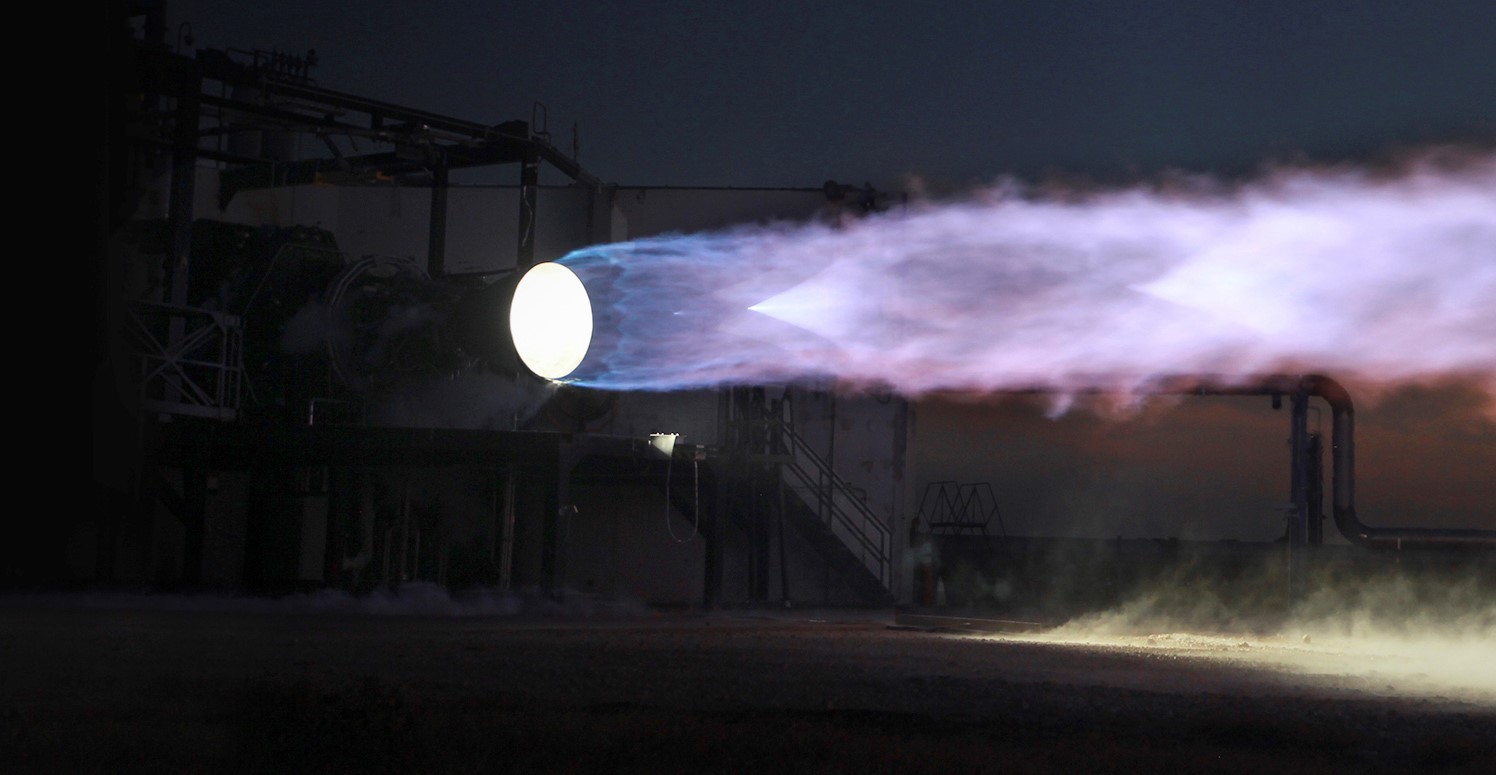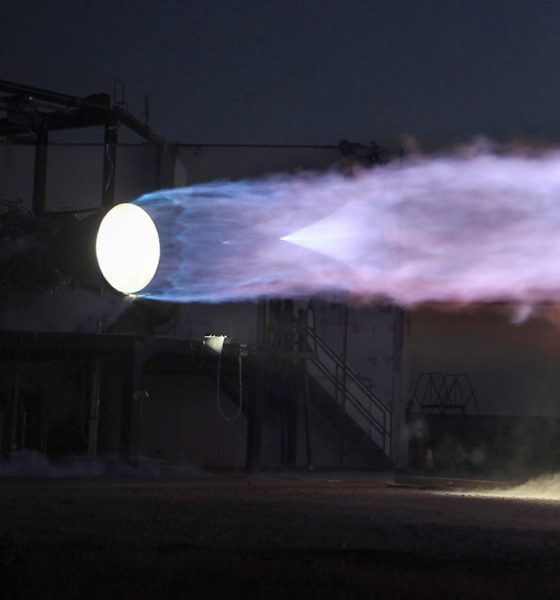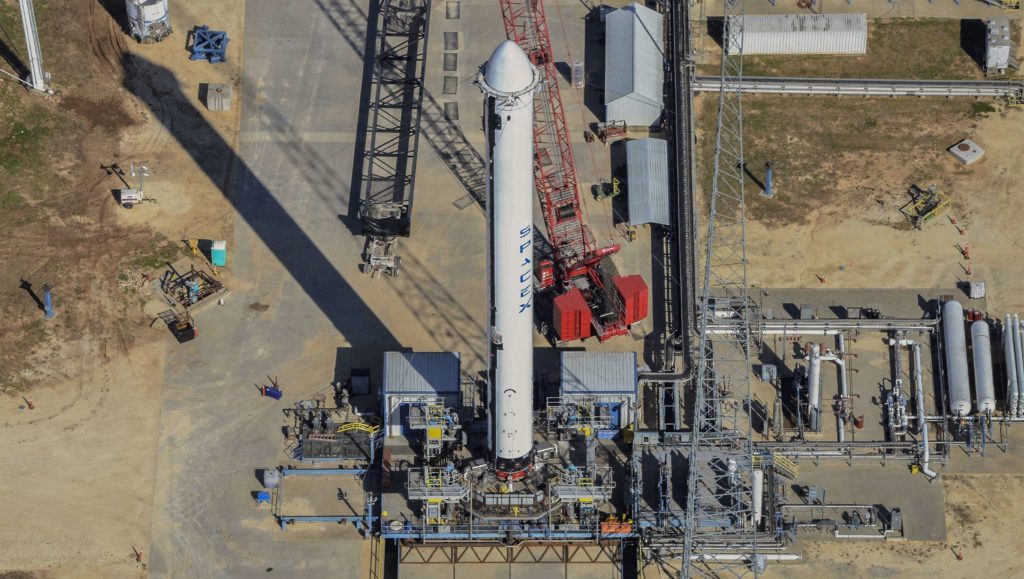

News
SpaceX Starship’s Raptor engine test facilities are about to get a big upgrade, says Elon Musk
According to CEO Elon Musk, SpaceX’s Starship and Super Heavy rockets are about to get a new test stand that will enable additional and more useful static fire tests of their Raptor engines.
These modifications could reportedly lead to a simplified engine design and will generally expand SpaceX’s ability to rapidly acceptance-test a huge number of Raptors – a necessity given that each Starship/Super Heavy pair will need up to 43 engines.
Musk’s additional insight came by way of a tweet response to an article published today on NASASpaceflight.com, discussing SpaceX’s recently-unearthed plans to reactivate a test stand that hasn’t seen use in almost half a decade. Known as the tripod stand, the large concrete structure was originally built in the 1990s by Beal Aerospace, a now-defunct spaceflight startup, and came under SpaceX ownership when the company bought the McGregor, Texas facilities in 2003.
SpaceX repurposed the stand to static fire Falcon 9 boosters for a number of years, eventually replacing it with a ground-level installation in 2015 that has since been used to test more than 60 Falcon 9 (and Heavy) boosters. It’s not a huge surprise that SpaceX decided to make the change, given that the tripod stand necessarily placed Falcon boosters several hundred feet off the ground, making what was already a challenge even more arduous (and dangerous) for workers.
NASASpaceflight.com also notes that the stand produced far more noise pollution, encouraging SpaceX to move the replacement stand partially underground.

After four years of inactivity, NASASpaceflight.com photos show that SpaceX is well into the process of refurbishing McGregor’s tripod stand. This time, Musk says it will be modified to support vertical Raptor engine testing, likely requiring a new custom mount and new liquid methane and oxygen propellant farms.
By far the most interesting detail to come out of this development is Musk’s indication that moving Raptor static fires to a vertical stand could actually allow SpaceX to simplify the engine’s design by creating more flight-like test conditions (and thus better data). At the moment, all Raptor acceptance testing is done on a separate test stand located elsewhere at SpaceX’s McGregor facilities. Those stands are horizontal, an engineering decision likely motivated by their relatively cheap and fast construction thanks to sidestepping the need for large, water-cooled thrust diverters.

SpaceX does all of its Merlin Vacuum, Merlin 1D, Falcon 9 booster, and upper stage static fire testing on vertical stands at its McGregor facilities, with Raptor’s horizontal stands being the only exception to the rule. As such, it was likely just a matter of time before SpaceX replaced the horizontal Raptor facilities with vertical stands. Given that SpaceX plans to modify an entirely separate stand to support vertical testing, it’s likely that the company will modify the existing stands to support vertical testing as soon as the tripod stand is up and running.

For Falcon 9 and Heavy, SpaceX has relied on a total of five main engine/vehicle test stands: two for Merlin 1D, one for MVac, one for boosters, and one for upper stages. SpaceX builds engines and rockets in Hawthorne, tests every engine separately in Texas, returns them to Hawthorne, installs them on their respective booster/upper stage, and tests those stages in McGregor before they are shipped to their launch site.
Although that sounds undeniably arduous, the four stands pictured above (plus the F9 booster stand further up) have managed to support the entirety of SpaceX’s 82 launches. A new upper stage test stand is being built, but it has yet to be completed and is only necessary because Falcon 9 upper stages are expendable. According to SpaceX planning documents, Starship and Super Heavy will only perform static fire testing at the launch site. As such, something like the cluster of four Merlin stands above could very likely support the production and testing of 100-200+ Raptor engines annually, enough to build numerous boosters and ships.
SpaceX moves fast, so stay tuned for updates as work continues on the tripod stand and paves the way for even more significant changes at SpaceX’s McGregor, Texas test facilities.
Check out Teslarati’s Marketplace! We offer Tesla accessories, including for the Tesla Cybertruck and Tesla Model 3.

Elon Musk
Elon Musk’s X will start using a Tesla-like software update strategy
The initiative seems designed to accelerate updates to the social media platform, while maintaining maximum transparency.

Elon Musk’s social media platform X will adopt a Tesla-esque approach to software updates for its algorithm.
The initiative seems designed to accelerate updates to the social media platform, while maintaining maximum transparency.
X’s updates to its updates
As per Musk in a post on X, the social media company will be making a new algorithm to determine what organic and advertising posts are recommended to users. These updates would then be repeated every four weeks.
“We will make the new 𝕏 algorithm, including all code used to determine what organic and advertising posts are recommended to users, open source in 7 days. This will be repeated every 4 weeks, with comprehensive developer notes, to help you understand what changed,” Musk wrote in his post.
The initiative somewhat mirrors Tesla’s over-the-air update model, where vehicle software is regularly refined and pushed to users with detailed release notes. This should allow users to better understand the details of X’s every update and foster a healthy feedback loop for the social media platform.
xAI and X
X, formerly Twitter, has been acquired by Elon Musk’s artificial intelligence startup, xAI last year. Since then, xAI has seen a rapid rise in valuation. Following the company’s the company’s upsized $20 billion Series E funding round, estimates now suggest that xAI is worth tens about $230 to $235 billion. That’s several times larger than Tesla when Elon Musk received his controversial 2018 CEO Performance Award.
As per xAI, the Series E funding round attracted a diverse group of investors, including Valor Equity Partners, Stepstone Group, Fidelity Management & Research Company, Qatar Investment Authority, MGX, and Baron Capital Group, among others. Strategic partners NVIDIA and Cisco Investments also continued support for building the world’s largest GPU clusters.
News
Tesla FSD Supervised wins MotorTrend’s Best Driver Assistance Award
The decision marks a notable reversal for the publication from prior years, with judges citing major real-world improvements that pushed Tesla’s latest FSD software ahead of every competing ADAS system.

Tesla’s Full Self-Driving (Supervised) system has been named the best driver-assistance technology on the market, earning top honors at the 2026 MotorTrend Best Tech Awards.
The decision marks a notable reversal for the publication from prior years, with judges citing major real-world improvements that pushed Tesla’s latest FSD software ahead of every competing ADAS system. And it wasn’t even close.
MotorTrend reverses course
MotorTrend awarded Tesla FSD (Supervised) its 2026 Best Tech Driver Assistance title after extensive testing of the latest v14 software. The publication acknowledged that it had previously criticized earlier versions of FSD for erratic behavior and near-miss incidents, ultimately favoring rivals such as GM’s Super Cruise in earlier evaluations.
According to MotorTrend, the newest iteration of FSD resolved many of those shortcomings. Testers said v14 showed far smoother behavior in complex urban scenarios, including unprotected left turns, traffic circles, emergency vehicles, and dense city streets. While the system still requires constant driver supervision, judges concluded that no other advanced driver-assistance system currently matches its breadth of capability.
Unlike rival systems that rely on combinations of cameras, radar, lidar, and mapped highways, Tesla’s FSD operates using a camera-only approach and is capable of driving on city streets, rural roads, and freeways. MotorTrend stated that pure utility, the ability to handle nearly all road types, ultimately separated FSD from competitors like Ford BlueCruise, GM Super Cruise, and BMW’s Highway Assistant.
High cost and high capability
MotorTrend also addressed FSD’s pricing, which remains significantly higher than rival systems. Tesla currently charges $8,000 for a one-time purchase or $99 per month for a subscription, compared with far lower upfront and subscription costs from other automakers. The publication noted that the premium is justified given FSD’s unmatched scope and continuous software evolution.
Safety remained a central focus of the evaluation. While testers reported collision-free operation over thousands of miles, they noted ongoing concerns around FSD’s configurable driving modes, including options that allow aggressive driving and speeds beyond posted limits. MotorTrend emphasized that, like all Level 2 systems, FSD still depends on a fully attentive human driver at all times.
Despite those caveats, the publication concluded that Tesla’s rapid software progress fundamentally reshaped the competitive landscape. For drivers seeking the most capable hands-on driver-assistance system available today, MotorTrend concluded Tesla FSD (Supervised) now stands alone at the top.
News
Elon Musk’s Grokipedia surges to 5.6M articles, almost 79% of English Wikipedia
The explosive growth marks a major milestone for the AI-powered online encyclopedia, which was launched by Elon Musk’s xAI just months ago.

Elon Musk’s Grokipedia has grown to an impressive 5,615,201 articles as of today, closing in on 79% of the English Wikipedia’s current total of 7,119,376 articles.
The explosive growth marks a major milestone for the AI-powered online encyclopedia, which was launched by Elon Musk’s xAI just months ago. Needless to say, it would only be a matter of time before Grokipedia exceeds English Wikipedia in sheer volume.
Grokipedia’s rapid growth
xAI’s vision for Grokipedia emphasizes neutrality, while Grok’s reasoning capabilities allow for fast drafting and fact-checking. When Elon Musk announced the initiative in late September 2025, he noted that Grokipedia would be an improvement to Wikipedia because it would be designed to avoid bias.
At the time, Musk noted that Grokipedia “is a necessary step towards the xAI goal of understanding the Universe.”
Grokipedia was launched in late October, and while xAI was careful to list it only as Version 0.1 at the time, the online encyclopedia immediately earned praise. Wikipedia co-founder Larry Sanger highlighted the project’s innovative approach, noting how it leverages AI to fill knowledge gaps and enable rapid updates. Netizens also observed how Grokipedia tends to present articles in a more objective manner compared to Wikipedia, which is edited by humans.
Elon Musk’s ambitious plans
With 5,615,201 total articles, Grokipedia has now grown to almost 79% of English Wikipedia’s article base. This is incredibly quick, though Grokipedia remains text-only for now. xAI, for its part, has now updated the online encyclopedia’s iteration to v0.2.
Elon Musk has shared bold ideas for Grokipedia, including sending a record of the entire knowledge base to space as part of xAI’s mission to preserve and expand human understanding. At some point, Musk stated that Grokipedia will be renamed to Encyclopedia Galactica, and it will be sent to the cosmos.
“When Grokipedia is good enough (long way to go), we will change the name to Encyclopedia Galactica. It will be an open source distillation of all knowledge, including audio, images and video. Join xAI to help build the sci-fi version of the Library of Alexandria!” Musk wrote, adding in a later post that “Copies will be etched in stone and sent to the Moon, Mars and beyond. This time, it will not be lost.”








